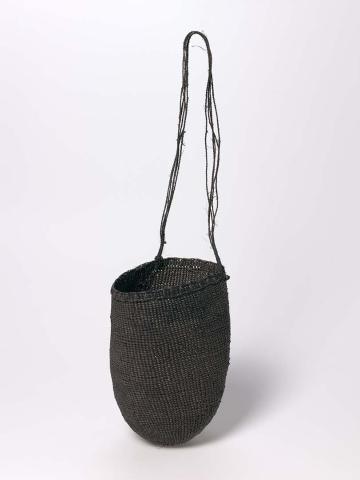Margaret Rarru and Helen Ganalmirriwuy
APT9
Born 1940 and 1955 Galiwin’ku (Elcho Island), Northern Territory, Australia
Live and work in Yurrwi (Milingimbi) and Langarra (Howard Island)
Sisters Margaret Rarru (b.1940) and Helen Ganalmirriwuy (b.1955) are master weavers who also paint their clan body designs in minimalist patterns on barks and poles. They live and work on Yurrwi (Milingimbi) and Langarra (Howard Island) off the northern coast of eastern Arnhem Land. Rarru and Ganalmirriwuy both learnt early in life the deep meanings of woven fibre objects and the techniques to make them. In the 1980s, Rarru began experimenting with the coil-weaving technique to make sculptural forms. More recently, both sisters have experimented with colour, developing a rare strong black from local leaves. This dramatic shift was first seen in the austere, classical forms of mindirr (conical baskets), and more recently in coil-woven forms where the dark, almost metallic, tightly-woven surface becomes a subtly textured field.

Margaret Rarru / Liyagawumirr people / Australia NT b.1940 / Mindirr 2012 / Pandanus palm with natural dyes / 29x17; 32x19; 34x19; 29x17cm (clockwise l–r) / Purchased 2012 with funds from an anonymous donor through the Queensland Art Gallery Foundation / Collection: QAGOMA / © © Margaret Bilinydjan Rarru/Copyright Agency / Photograph: N Harth, QAGOMA
Born in Arnhem Land in the Northern Territory, Margaret Rarru and her sister Helen Ganalmirriwuy were taught the poetic meanings of ancient Aboriginal creation narratives by their father while they were young. The stark images of clan designs on sheets of bark and wooden memorial poles, depicted in distinctive earth pigments — red (miku), white (watharr) and yellow (buthjalak) — originate from the ritual markings painted on the bodies of Liyagawumirr people during important ceremonies. In 2006 (unusually for women at the time), they inherited the right to paint these sacred images following the death of their brother, renowned painter Mickey Durrng (c.1940–2006). The sisters’ creative approach consequently sparked a Liyagawumirr cultural revival.
Having also learnt the cultural meanings of traditional woven fibre objects, the women perfected a range of weaving processes and techniques to make sacred and utilitarian basketry. Following their discovery of a rare black vegetable dye (achieved in a secret process), the sisters developed their unique bathi mul (black baskets). Pandanus leaf strands saturated with rich colour are twined into conical forms, or coiled into solid, sculptural vessels. The woven surfaces of these forms take on a metallic gleam and display subtle textural variations within graded fields of black.
Living remotely on their island homes of Yurrwi (Milingimbi) and Langarra (Howard Island), Margaret Rarru and Helen Ganalmirriwuy have established a reputation as two of the finest and most innovative textile artists in Australia.
Learn more about the artists:
GANALMIRRIWUY, Helen
1955
- present
Full profile
for GANALMIRRIWUY, Helen
RARRU, Margaret
1940
- present
Full profile
for RARRU, Margaret

Mindirr 2018
- GANALMIRRIWUY, Helen - Creator

Mindirr 2018
- GANALMIRRIWUY, Helen - Creator

Bathi Mul 2018
- GANALMIRRIWUY, Helen - Creator

Bowl form 2018
- GANALMIRRIWUY, Helen - Creator

Mindirr 2018
- RARRU, Margaret - Creator

Mindirr 2018
- RARRU, Margaret - Creator

Mindirr 2011
- RARRU, Margaret - Creator

Mindirr 2018
- RARRU, Margaret - Creator

Mindirr 2012
- RARRU, Margaret - Creator

Bathi Mul 2018
- RARRU, Margaret - Creator

Bathi Mul 2018
- RARRU, Margaret - Creator

Mindirr 2012
- RARRU, Margaret - Creator

Mindirr 2012
- RARRU, Margaret - Creator

Mindirr 2012
- RARRU, Margaret - Creator

Mindirr 2012
- RARRU, Margaret - Creator

Mindirr 2012
- RARRU, Margaret - Creator
